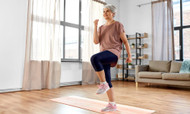5 Healthy Tips for Exercising With Incontinence
Posted by Aaron Baker on May 9th 2023

One fear that many people have after finding out they have incontinence is that they won’t be able to exercise anymore. Fortunately, that’s not true at all. In fact, exercise is highly encouraged by medical professionals.
You just need to be a little more careful about what you choose to do. That’s why we’re here today to review some healthy tips for exercising with incontinence. You shouldn’t run into any significant issues as long as you follow these.
Be Careful of What You Eat Beforehand
Before you even start working out, you need to keep track of what you eat. Obviously, you’ll want to avoid food that could upset your bladder. Most people know to do this, but you might not know that big meals are also a bad idea.
Not only will they make it harder to get going once you start working out, but they will put a lot more pressure on your pelvic muscles, making it more difficult for you to control your bladder. Be sure to stick to light, healthy meals before going to the gym.
Pick the Right Exercises
Once you get to the gym, it’ll be time to decide what you want to do. In general, avoiding high-impact activities or ones that put unnecessary pressure on your pelvic muscles is a good idea. Yoga, Pilates, and running the elliptical are great options to avoid these potential triggers. If your gym has a pool, you can also try swimming.
Focus on Strengthening Your Pelvic Floor
However, this doesn’t mean you should avoid the pelvic region altogether. One of the best ways to improve your incontinence symptoms is to strengthen your pelvic floor. Kegel exercises are the best for this, but there are many other exercises that you can learn that help build up your pelvic muscles.
Stay Hydrated
One of the biggest mistakes people with incontinence make at the gym is avoiding the drinking station. Staying hydrated is the most crucial healthy thing you can do for your body when exercising with incontinence since your muscles need water to function properly.
Those with this medical condition tend to avoid drinking too much water for fear of having an issue while in the middle of working out. Fortunately, this isn’t something you should even worry about in the first place. While exercising, you’ll sweat a lot, keeping your bladder from needing to remove as much waste as it normally would when your water intake increases.
Use the Right Incontinence Products
No matter how good you feel while working out, it’s always a good idea to ensure you’re protected. That’s why you need to use incontinence products that fit comfortably while exercising. Everyone has their own preferences, but pull-on incontinence briefs are a popular option for those with this issue. These briefs tend to be more flexible, which helps with movement and making sure you don’t experience any leakages at the gym.

